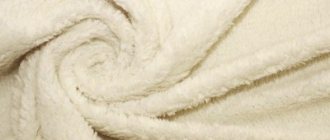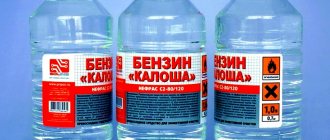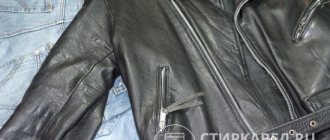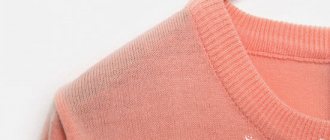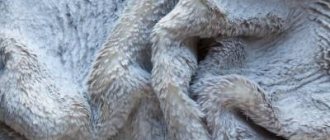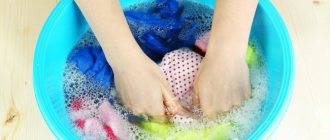A curtain is an important bathroom accessory that prevents water from splashing when taking water procedures and serves as a decoration for the room.
Constantly being in a humid environment, curtains also require washing and removing stains from mold, lime and rust. This treatment will help maintain the hygiene of the room and refresh the material.
Is it possible and how to wash a bath curtain (made of polyester and other materials) in a washing machine and by hand to get rid of mold, yellowness and limescale, read the article.
Are there any restrictions for washing curtains?
Improper washing of bathroom curtains can lead to damage and loss of presentable appearance.
The cleaning method directly depends on the material the curtain is made of.
The most common include:
- polyvinyl chloride;
- polyester;
- polyethylene.
PVC and polyester
Vinyl and polyester for the most part are able to survive washing and maintain their appearance and performance . Restrictions on cleaning may be given by the manufacturer of a particular product, so you should read the label on the product before washing.
The manufacturer may prohibit machine washing, as well as the use of bleaches. In this case, it is better not to experiment and treat the curtains with your hands with an approved detergent.
If there are no strict restrictions, then automatic washing in a washing machine will be the best option. The exception is the need to remove stains characteristic of the bathroom: from rust, mold or limescale. Household chemicals and homemade recipes are used for these purposes.
Polyethylene
Among all the types of materials that are traditionally used to organize curtains in the bathroom, polyethylene is the cheapest and most fragile.
It is capable of good protection against splashing, but has a very short service life - up to six months.
Such material will not survive thorough washing . Maximum cleaning is a careful treatment with a non-aggressive agent. For example, Pemolux.
Cleaning is carried out with a soft sponge, without using brushes, which can damage the thin material. In case of serious contamination, the plastic curtain is simply replaced with a new one.
Is it possible to wash the curtain in a machine?
The curtain can be machine washed once a month.
Vinyl products are recommended to be machine washed once a month.
During this process, the following points are taken into account:
- It is necessary to select a delicate wash mode, and the temperature should be up to 40 °C. The label indicates the maximum acceptable temperature for this product.
- During washing, add stain remover and powder (or bleach).
- Turn off the drying and spinning function, otherwise the curtain will become deformed.
- If the shower curtain has rings, then the product is placed in a bag or pillowcase. A fallen ring may get stuck in the machine mechanism, causing it to jam or clog the drain filter.
- Towels are placed in the drum to act as brushes.
Read more ► Limescale and urinary stone in the toilet: how to remove it and how to clean it at home?
Manually
For curtains that require delicate handling, hand wash only.
With this method, the curtain is soaked in advance in a suitable detergent solution. This could be laundry soap, powder or bleach. The choice is limited only by the manufacturer's recommendations.
To clean the curtain you will need:
pelvis;- brush;
- water;
- detergent.
Washing procedure:
- Pour warm water into the basin (temperature no more than +40°C).
- Dilute the powder (or other detergent) according to the instructions on the package.
- Dip the curtain into the prepared solution.
- Using a brush, it is necessary to treat contaminated areas and seams of the product. You need to go over both sides of the curtain with a brush.
- For heavily soiled curtains, you can supplement cleaning with baking soda. Take ½ cup of it and dilute it with water to a paste. This mixture can be used to treat heavily soiled areas.
- After washing, the curtain is rinsed in water.
- The curtain is shaken and hung in place, lowering the bottom edge into the bath.
For stains from rust, mold or lime, it is recommended to treat them first, and only then wash the entire product.
How to wash a bathroom curtain by hand, video instructions:
Rules for caring for a bath curtain
In order for bath curtains to serve faithfully for more than one month or even a year, you should follow simple rules that will allow them to maintain their shape and color for a long time.
- Every time after taking a shower, it is advisable to wipe the curtain from top to bottom with a dry cloth.
- After bathing, leave the bathroom door open to prevent steam from settling on surfaces.
- If you don't have the time or desire to dry the linen every time, you can simply shake off the droplets into the bath.
- Before washing a bathroom curtain in a machine, remove the weights from it (for fabric curtains). And if they are not removable, wash the material by hand, being careful not to wet the bottom of the product.
- When cleaning stains, do not use hard brushes - they can damage the material and even tear the polyethylene.
Is it possible to put it in the washing machine?
Washing curtains in a washing machine is the easiest way to freshen the material. If curtains are used regularly, such treatment should be carried out once every 60-90 days.
Procedure:
Remove the curtain.- If it has removable fasteners or removable decor, they must be removed.
- Place the product in the drum.
- Select the “Delicate” mode.
- Make sure that the temperature is no more than 40°C.
- Disable the “Drying” and “Spin” modes.
- Start the machine.
- Remove the wet curtain from the drum and hang it in place, allowing the water to drain into the bathroom.
Adding two terry towels to the load with a curtain will help enhance the effect of washing. Their rough surface will help clean the curtain better.
This treatment is suitable for curtains that are not heavily soiled. Otherwise, it is advisable to start washing by pre-soaking and treating stains.
The detergent for this procedure should be selected following the recommendations of the curtain manufacturer. If they do not specify strict restrictions, then it is possible to use bleach or other products with chlorine.
With strict restrictions, oxygen-containing bleach without chlorine will help. For example, Vanish. Soaking should be carried out in accordance with the instructions for the specific detergent, and do not use hot water.
How to wash a bathroom curtain made of polyester (oilcloth), vinyl or fabric
There are several ways to clean curtains. The most gentle way is by hand, but in some cases it is also allowed in the washing machine. The method depends on the material of the canvas.
Manually
For this type of curtain cleaning, both regular powder and other products can be used. For example, toilet or laundry soap, as well as chlorine-free stain removers or even dishwashing gel.
Hand washing is used when light soiling occurs, for example, from soap, foam or other products used when taking a shower.
Tip: if you are going to wash the curtain immediately after water procedures, most often you just need to rinse it with a warm stream from a watering can.
If this does not help, you can go over the canvas with a clean foam sponge, using its hard side. And then wash off the remaining dirt with water again.
To make the process easier, when washing, you need to place your palm on the back side to form a hard surface.
Water temperature plays an important role when cleaning stains. For a material such as polyethylene (oilcloth), the optimal value is 30-40°C, since at higher values the color may lose its brightness.
A vinyl curtain is much more resistant to hot water due to a special impregnation applied to its surface. It also ensures the durability of the product, so it can be used for more than one year. For comparison, polyethylene curtains have to be changed at least 2-3 times a year due to their fragility.
Therefore, vinyl curtains can be wiped in hot (60-70 degrees) water. At the same time, they will not lose color and retain their shape. For cleaning, you can use any non-aggressive detergents - dish gels, washing powder, soap or Vanish.
Fabric curtains also have a water-repellent layer, thanks to which the material does not become covered with moldy spots even after a long time. It is advisable to wash this fabric by hand at a temperature of no more than 30 degrees. The powder must be marked “for delicate fabrics.” After washing, the material is rinsed in warm water several times. You need to dry it naturally, hiding it from direct sunlight.
The advantage of hand washing is that you can control the reaction of the products used to remove stains. But in a car, the final result, including a negative one, will appear only after you remove the curtains from the drum.
Can it be machine washed?
Yes, this is allowed, but subject to certain rules. For example, it is still advisable to wash a vinyl curtain by hand, since its structure is denser than a plastic curtain. As a result, during intensive washing, creases or microcracks may form into which dirt can penetrate. Accordingly, over time, such a curtain will take on a not very aesthetic appearance.
Before washing any bathroom curtains, you should first determine the water temperature. It is usually indicated in the instructions for their use. For example, for fabric curtains you should choose a heating mode of no more than 30 degrees. But you need to take into account that special weighting agents are often inserted into such curtains to give them shape. You must remove them before washing. Otherwise, the drum may be damaged.
In this regard, polyethylene curtains are the most practical and convenient, as they are made of thin material.
The curtains need to be placed in the drum, select the desired mode, turning off the spin and drying functions. To completely wash the material from soapy water, add another rinse to the main one.
After washing, all that remains is to dry the curtain naturally.
Important: wringing out or twisting the canvas after removing it from the drum is prohibited! It is better to leave it to flow over the bathtub in a straightened form.
The disadvantage of washing it in the machine is that the curtain then looks wrinkled. If it is polyethylene or vinyl, there is practically nothing that can be done here; it will restore its shape over time. And if these are fabric curtains, they can be ironed at a minimum temperature so as not to melt the protective water-repellent layer.
How to clean without removing?
In order for the curtain in the bathroom to retain its presentable appearance longer and serve for a long time, it must not only be washed periodically, but also regularly looked after between washes.
For this processing you will need:
- spray bottle;
- sponge;
- detergent dissolved in water.
For processing, it is advisable to use a detergent in gel form.
Procedure:
- Dilute detergent in water.
- Pour it into a spray bottle.
- Spray the cleaner over the surface of the curtain.
- Wipe the material with a sponge.
- Wash off the detergent composition using a sponge or rag.
Such treatment, without removing the curtain, will not replace a full wash, but will help maintain the hygiene of the curtain. And it will not allow the formation of difficult-to-remove contaminants.
How to use the “Whiteness” product
Light curtains are difficult to wash from stains, since the slightest stains and stains are visible on white things. In this case, use the “Whiteness” product, which helps solve several problems:
- Maintain a fresh and neat appearance. To do this, fill a bowl with cool water and add 2 tbsp. l. cleaning agent. The curtain is soaked for 20 minutes and then rinsed. If necessary, it can be washed by hand or in a machine.
- Remove stains, grayness and yellowness. 2 large spoons of “Whiteness” are added to 10 liters of water, after which the curtain is soaked for 1 hour.
- Bleaching even thick fabric. “Whiteness” is applied to problem areas of the curtain, but should not be left on for more than 1 minute. Next, the item is soaked and washed.
Attention! Frequent use of chlorine-containing bleaches is dangerous for the product, as there is a risk of damage to the fibers. It is recommended to replace aggressive chemicals with safer products. However, they usually have another drawback - high price.
We recommend:
How to wash a padding polyester jacket in a washing machine
Features of treatment against mold and mildew
A damp bathroom environment and warmth are optimal conditions for mold to grow. Regular washing will not be enough to completely eliminate pathogenic organisms. Proven recipes will come to the rescue.
Citric acid and soda
In order to eliminate mold, a combination of mechanical and chemical treatment is needed. For cleaning you will need:
- citric acid (1 package of 50 grams);
- brush;
- soda (1/2 cup).
Progress:
Remove the curtain and place it on the bottom of a large basin.- Dilute baking soda with water to obtain a creamy texture.
- Rinse the curtain with water. You can use a shower head for this.
- Scrub mold stains with a brush and soda slurry.
- Plug the drain in the bathroom and fill with approximately 10 liters of water at a temperature of +35°C to +40°C.
- Dilute citric acid in water.
- Rinse the curtain thoroughly in the prepared solution.
- Hang the curtain in its designated place.
Vinegar and baking soda or bleach
Exposure to baking soda (or oxygen-containing bleach) and an aqueous solution of vinegar will help deal with mold.
Operating procedure:
- The cleaning paste is prepared in advance. For it, use ½ cup of soda or bleach and a little water so that the consistency is like gruel.
- The curtain is removed and moistened with water.
- Transfer to a basin.
- Using a sponge and baking soda, scrub off all stains.
- Pour a large bucket of water into a basin, add 1 cup of vinegar and add ½ cup of soda.
- The curtain is immersed in a basin.
- Leave for 1 hour.
- Rinse the curtain.
- They take it out.
- Without squeezing, hang it over the bathtub.
Domestos
The use of Domestos is one of the effective means in the fight against mold.
Procedure:
Apply a few drops of Domestos to a damp sponge;- distribute the product over the entire surface, paying special attention to areas blackened by mold;
- leave the curtain in the basin for a quarter of an hour;
- wash by hand;
- rinse in water;
- hang it so that excess moisture drains into the bath.
Recommendations and precautions
Cleaning the curtains in the bathroom from plaque and dirt can take a lot of time, since with constant changes in humidity in the room, the material deteriorates faster and absorbs bacteria more easily.
However, there are some recommendations, following which you can simplify and protect the care of the product:
- When cleaning the curtain, be sure to wear thick rubber gloves to avoid exposing your sensitive hands to chemicals and causing further irritation or an allergic reaction.
- When cleaning material from fungus, wear a respirator and ensure constant air circulation in the bathroom (for example, by turning on a fan or exhaust hood).
- If you need to wash only the bottom of the curtain, do not remove it from the holder, but just hang it in the inside of the bathtub for convenience.
- Before washing the bath curtain, study the features and properties of the material from which it is made to avoid deformation.
- If the curtain is fixed with ring fastenings, remove them first. During both machine and hand washing, they can break, deteriorate, or simply get in your way.
- At the end of washing, soak the curtain for 20-30 minutes in a saline solution. This forms a transparent protective film on it, which will repel dirt and bacteria. Thanks to this, you will have to wash the material less often.
If, after repeated attempts to clean the curtain from yellow plaque or fungus, it still does not reach the desired state, it is better to replace it with a new one. In the future, pay attention to constant ventilation of the bathroom. This will be useful not only for the curtain itself, but also for other things and interior items located in a room with a high level of humidity.
Methods for removing limescale
Frequent contact of curtain material with hard water can lead to limescale stains. This formation spoils the appearance and reduces the service life of the curtain.
Lemon acid
For processing you will need:
- citric acid (1 small bag);
- water;
- pelvis;
- brush.
Progress:
- Pour 2 liters of water into a basin.
- Dissolve citric acid in water.
- Soak stained areas for 60 minutes.
- Brush over lime stains.
- Rinse the product.
In order to eliminate lime stains, it is not necessary to treat the entire surface with the selected product. It is quite enough to clean only the stains, and then simply wash the product in the usual way.
Vinegar
Yellow deposits on the material can be removed with table vinegar. For processing you will need:
- pelvis;
- vinegar;
- tablespoon;
- water;
- brush.
Processing includes the following steps:
- Pour water (2 liters) into a basin.
- Measure vinegar (3 tablespoons) into water.
- Soak areas affected by lime deposits (or the entire curtain) in a basin.
- Leave for 60 minutes.
- Scrub stains with a brush.
- Rinse.
- Hang.
Vanish
Traces of water drops that have dried on the curtain are not aesthetically pleasing and require timely removal. In addition to homemade recipes, household chemicals designed to remove difficult stains will come to the rescue. Examples of such drugs are Vanish and Ace.
The selected product is used according to the instructions indicated on the package. Rub stains with a sponge. After treatment, rinse and wash in the usual way, adding Vanish to the detergent.
Lemon acid
Lemon is known for its bleaching and antibacterial properties, so it can be used to clean yellowed curtains.
Instructions:
- Pour 2 liters of water into a deep container.
- Add a packet of citric acid and stir.
- Soak the curtain in the liquid for an hour, and then additionally clean visible stains with a soft brush.
- Rinse and hang to dry without wringing.
Instead of citric acid, fresh fruit juice is suitable. For washing, prepare a solution from the juice of five lemons and 1 liter of water, and then carry out the treatment according to the same principle.
Removing rust and yellowness
Traces of rust can form from contact of the curtain with wet metal. Regular washing may not remove them, so it is recommended to use homemade recipes for treating this type of stain .
Hydrogen peroxide and ammonia
To treat rust stains on the material, you can use a simple recipe using drugs from your home medicine cabinet.
For cleaning you will need:
- hydrogen peroxide (50 ml);
- ammonia (150 ml):
- sponge;
- water.
Curtain processing procedure:
- Combine ammonia and peroxide in a bowl.
- Dipping the sponge into the solution, treat all stains with the liquid.
- Rinse.
- Wash as usual.
Household chemicals
You can deal with rust using household chemicals:
- "Adrilan";
- "Sanita" and others.
Processing order:
- Apply a small amount of the selected product to the sponge.
- Rub stains with a sponge.
- Leave for 5 minutes.
- Rub the stained areas again with a sponge.
- Rinse off with plenty of water.
- Wash.
Partial washout
If, in general, the bathroom curtain looks clean, but only a certain area is dirty, then you don’t have to wash it completely, but just clean the stain itself.
The following types of contamination may occur on the curtain material:
- rusty stains;
- a thin layer of lime;
- mold and fungal stains;
- white stains;
- yellowness.
Next, we will consider ways to deal with each case.
How to remove rust and plaque
Rusty contaminants can form on the material due to prolonged contact with water. Usually it flows down and lingers in the lower part of the curtain, especially if it has special weights at the bottom. Cleaning off dirt will not be difficult, but only when the stains are still fresh. In this case, it is enough to simply wipe them with a sponge or soft brush dipped in soapy water.
If the contamination is old, you can use one of the following remedies:
- A mixture of ammonia and hydrogen peroxide - combine these substances in a ratio of 3 to 1. Moisten the stain generously and leave for 5 minutes for complete absorption. This method is suitable for cleaning fabric and vinyl materials. If rusty stains appear on the polyethylene, it is better to replace the curtain with a new one.
- Add one teaspoon of 9% acetic acid to 200 ml of warm water and mix thoroughly. Then put the solution on low heat and heat to maximum temperature, but do not bring to a boil. After this, add 5 drops of ammonia and baking soda to the liquid on the tip of a tablespoon. Allow the solution to cool slightly, and then dip the area with the stain into it. Leave for 10 minutes and then wash the material by hand.
To remove dried cloudy film, just soak the canvas in a bowl of warm water using Vanish or Domestos for an hour and a half. To do this, add one measuring spoon of the product to 5 liters of liquid. Then the curtain should be washed in the usual way using powder.
Mold and mildew removal
Such stains also arise from constant contact with moisture, but unlike rusty ones, they can appear on a wide variety of areas of the material.
If these types of contamination occur on inexpensive curtains, for example, on polyethylene curtains, it is better to immediately replace the product with another one. It's quite inexpensive.
If stains appear on fabric or vinyl, use the following cleaning method:
- First, the product must be soaked in warm water for 30 minutes;
- then the product must be removed and the wet area rubbed with baking soda using a dishwashing sponge;
- after that, soak again in warm water with the addition of the juice of half a lemon or one sachet of citric acid;
- rinse the item and dry it.
White stains
They appear as a result of hard water flowing down the curtain fabric, so for prevention you need to wipe its surface with a dry cloth every time after taking a shower.
If stains still appear, you can rinse the fabric in warm water with the addition of the juice of half a lemon per liter.
The second method is to soak the curtain for half an hour in warm water with the addition of chlorine bleach (about 50 ml per 5 liters). Then wash the product by hand or in a machine.
How to remove yellowness
Yellow stains on the material of bathroom curtains most often appear due to the fact that the products used for showering fall on the canvas, but are not completely washed off with water. Therefore, in order to prevent the appearance of such contaminants, it is enough to thoroughly rinse the material from the watering can every time after a shower.
There are several ways to remove ingrained yellow stains from a bathroom curtain:
- soak the curtain in warm water with the addition of one sachet of citric acid per 5 liters. Leave for 5 minutes. Rinse the product thoroughly with your hands, making sure to wear rubber gloves;
- Wipe the contaminated areas of the canvas with baking soda slurry using a soft brush. Wait no more than three minutes, then rinse the material.
Drying
The shower curtain is designed for constant contact with water. This does not harm the material. Proper drying includes observing the following rules:
prohibition on twisting and squeezing;- The best way to avoid wrinkles is to immediately hang the item vertically after washing to allow the water to drain;
- if possible, after washing it is recommended to hang the curtain in a permanent place above the bathtub;
- You should not try to speed up drying using heating devices, much less an open fire;
- You should not hang a wet curtain in a place where it will be exposed to direct sunlight.
Whiteness and vinegar
This vigorous mixture will clean the curtain from rust, white stains and mold. To obtain a solution, mix 120 ml of vinegar and 50 ml of bleach. Then the curtain is lowered into the solution and washed by hand, lightly rubbing the parts of the product together.
After hand washing, the curtain can be rinsed with lemon juice diluted with water 1 to 1, and then rinsed under water.
What mode should I use to wash a bathroom curtain?
Shower curtains made of thick materials tolerate machine washing well, but require careful handling. The mode for processing the product should be set to delicate, intended for sensitive fabrics. Since spinning and automatic drying can damage the curtain, these functions should be turned off before washing.
Shower curtains made of dense materials can be washed in a machine, but automatic equipment will damage oilcloth.
The detergent should be selected based on the manufacturer’s recommendations. You can wash a bathroom curtain made of polyester and similar materials with chlorine-containing powders if the product is durable and uniform in color. For thin and bright multi-colored items, it is better to use gentle washing gels and oxygen bleaches.
Possible contamination
Dirty bathroom curtains do not look very attractive, especially if they are light colors. Any stains, traces of mold and rust are immediately noticeable and, moreover, can cause the development of allergies. The easiest option is to throw away the damaged product. But the cost of high-quality curtains now is not small and it is better to try to bring the curtain to its original form. First of all, you need to know what types of contaminants can appear on a piece of bathroom furniture:
- yellowness and rust. Such defects usually appear at the bottom of the curtain due to constant contact with soapy water and foam;
- whitish stains. Appear on the curtain if the water in the tap flows with a high content of calcium and magnesium salts, due to which it becomes hard. After the drops dry, white marks remain on the product;
- fungus or mold. These living organisms reproduce where a warm and humid environment is present. The bathroom is just such a room. Fungi and traces of mold can often be seen on furniture, walls and curtains when there is no quality ventilation.
Fungus on a bathroom curtain - possible contamination
Of course, it is better to prevent such situations from occurring, but if this has already happened, you should know what control methods exist.
Preparing for cleaning
If it's time to wash your bath and shower curtains, there are a number of things to consider, namely:
Determine what material it is made of. Bath curtains are made from the following materials:
- Polyvinyl chloride, or PVC. These budget models are transparent or colored oilcloth of varying degrees of density.
- Polyester. Such curtains are used most often, as they are easy to care for, comfortable and durable.
There are also blends made of polyester with the addition of cotton or linen. Curtains of this class have a high price, so they are rare. Models such as two-layer or with hydrophobic impregnation are usually sewn independently or ordered from designers. As a rule, fabrics are selected according to technical parameters with comparable washing conditions.
The second step is to assess the degree of contamination and decide on the cleaning method. So, if individual stains have formed on the item or only the lower part has been damaged, you can wash it locally without removing it from the bar. When the product is heavily soiled, it must be removed from the holder and disconnected from the rings. If this is not done, they may break during machine washing and will interfere with hand washing.
The third step is to choose a washing method. Of course, automated is preferable. But, is it possible to wash a bathroom curtain using a washing machine? Yes, but not any one. Only woven items are suitable for automatic washing. Vinyl curtains are cleaned exclusively by hand.
Tips from the professionals
To ensure that the washing goes without any unpleasant surprises, it is recommended that you familiarize yourself with useful tips from professionals. Knowing a few secrets and nuances, it is easy to speed up the cleaning process and reduce the risk of damage to the material to a minimum. We are talking about the following rules:
- do not wash the curtain as an ordinary thing, do not rub the fabric against the fabric (otherwise the fibers will deteriorate and become deformed);
- For cleaning the canvas, a foam sponge, an old toothbrush, or a soft cloth are suitable;
- It is forbidden to iron the shower film - it cannot withstand high temperatures;
- The curtain is dried in a vertical position naturally (without ultraviolet radiation or heating devices).
There is one more trick that will help keep your curtains clean longer. So, if you rinse the curtain in salted water for the final time, a film will form on the surface of the material, preventing dirt and dust from settling.



